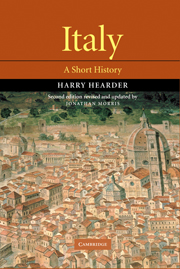Book contents
- Frontmatter
- Contents
- List of illustrations
- Preface
- 1 Italy in the classical world
- 2 The early Middle Ages
- 3 The high Middle Ages
- 4 The Renaissance
- 5 The political and cultural eclipse of Italy
- 6 The Risorgimento, 1790–1861
- 7 From Unification to Fascism, 1861–1922
- 8 The Fascist disaster, 1922–45
- 9 Italy since the Second World War, 1945–80
- Epilogue: From the First to the Second Republic: Italy 1980–2001
- A brief guide to further reading
- Index
4 - The Renaissance
Published online by Cambridge University Press: 05 February 2015
- Frontmatter
- Contents
- List of illustrations
- Preface
- 1 Italy in the classical world
- 2 The early Middle Ages
- 3 The high Middle Ages
- 4 The Renaissance
- 5 The political and cultural eclipse of Italy
- 6 The Risorgimento, 1790–1861
- 7 From Unification to Fascism, 1861–1922
- 8 The Fascist disaster, 1922–45
- 9 Italy since the Second World War, 1945–80
- Epilogue: From the First to the Second Republic: Italy 1980–2001
- A brief guide to further reading
- Index
Summary
The Black Death and the economic recovery of the fifteenth century
In the age of Dante and Giotto, during the thirteenth century and at least the first two decades of the fourteenth century, Italy had experienced economic growth, in the sense that agricultural production and commercial activity had increased. There is some doubt as to continued growth in the period 1320–40, but if there were reverses, they were not great ones, although the population may have started to decline. In contrast the economic disasters of the middle of the fourteenth century were very real, and brought human suffering on a massive scale. There were four major famines between 1339 and 1375, which would not have been more disastrous than those of the previous century, had they not been accompanied by many wars. Large mercenary armies spread destruction. Perhaps the most impressive of these condottieri was the ‘Great Company’ founded in 1342, and led by an ex-friar, Moriale d'Albano. Later, others in the 1360s and 1370s were led by Ambrogio Visconti and the Englishman, Sir John Hawkwood, whose painting, by Paolo Uccello, is on the wall of the cathedral in Florence. But famines and wars were minor affairs compared with the horror of the Black Death of 1348, which struck when the resistance of Italians had already been lowered. One manifestation of economic decline had been the bankruptcies of great Florentine banking houses – the Peruzzi in 1343, the Acciaiuoli in 1345, the Bardi in 1346.
- Type
- Chapter
- Information
- ItalyA Short History, pp. 96 - 125Publisher: Cambridge University PressPrint publication year: 2001



